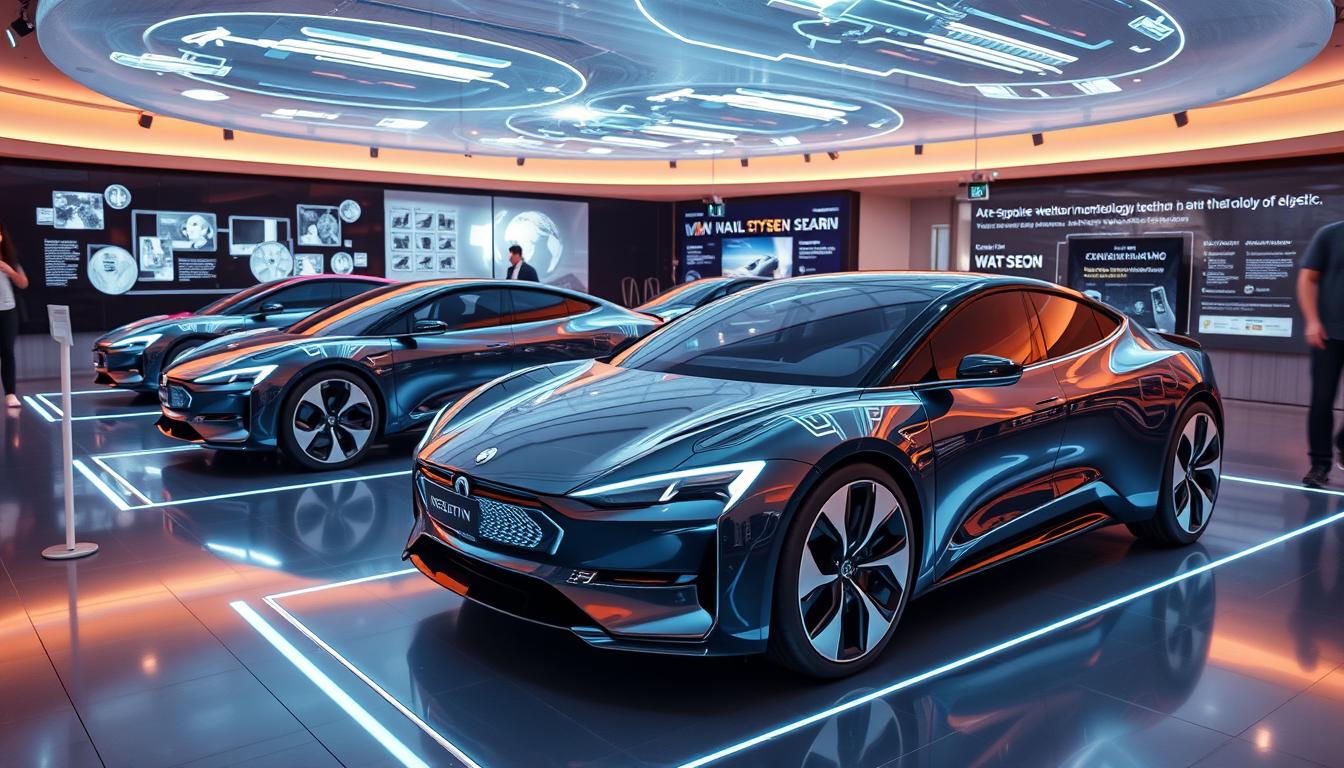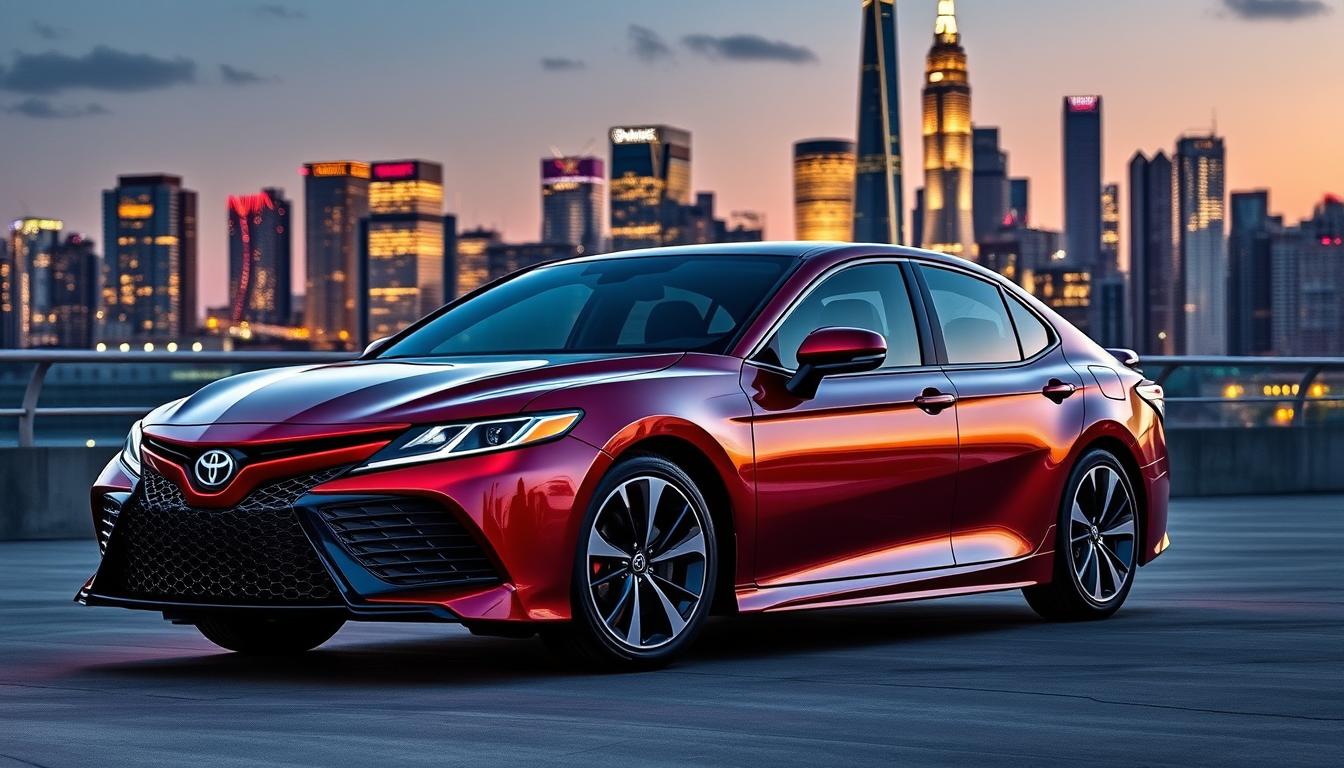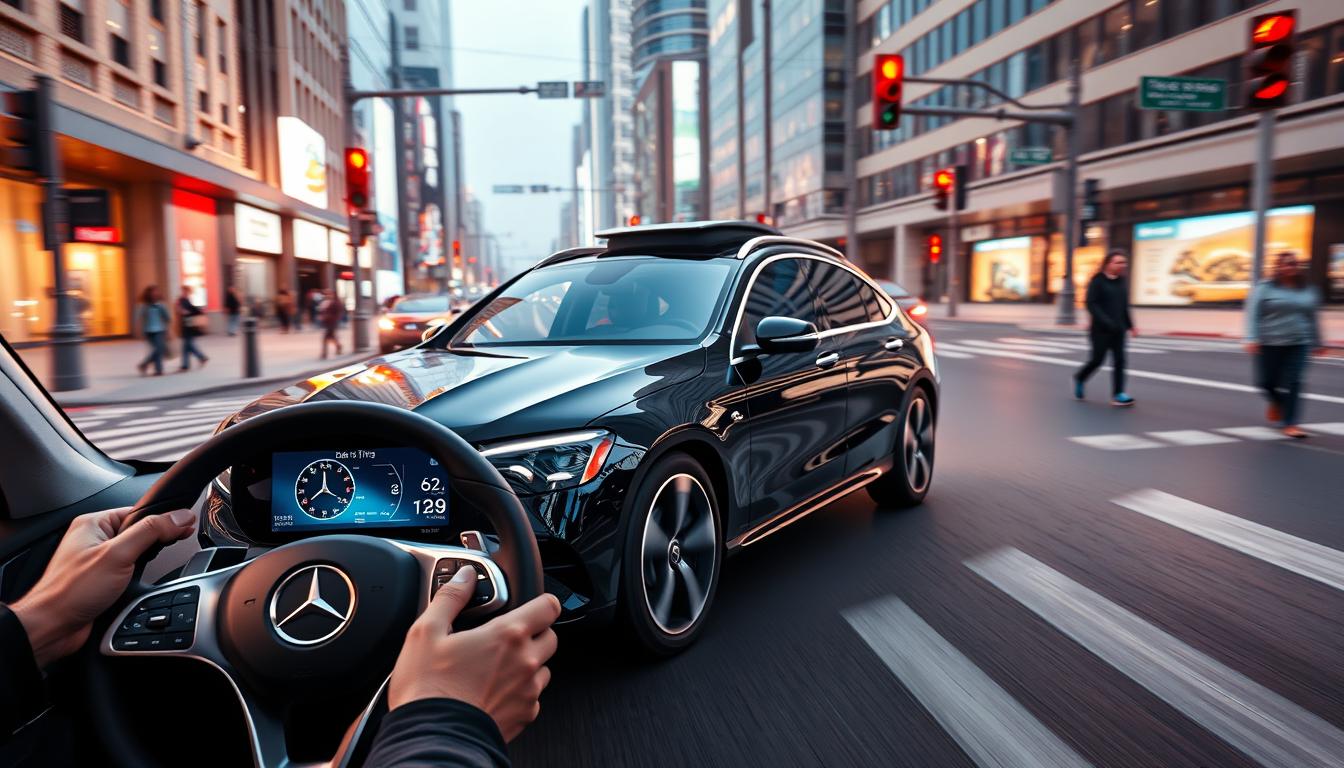The Future of Automotive Innovation and Smart Cars
We’re seeing a big change in cars. Smart cars and connected vehicles are now real. The China International Import Expo (CIIE) has been showing off new car tech since 2018.
This year at CIIE, 15 car brands are teaming up. They’re exploring “Mobility, Unlimited Possibilities in the Future.” We’re seeing big steps forward in car tech. Michelin is making tires from 71% sustainable materials. Yamaha is introducing TRICERA, a cool three-wheel electric autocycle.
The future of cars is electric. In EU5 countries, electric cars made up 47% of sales in 2022. By 2025, Europe aims for 45% electric cars. In the U.S., over a third of people are considering an electric car for their next purchase.
But electric cars aren’t the only thing getting smarter. They’re also getting safer. Did you know 97% of accidents are caused by human mistakes? That’s why self-driving tech is so promising. It could make our roads much safer.
The car industry is changing fast. We’re moving towards cleaner, smarter cars. Get ready for an exciting ride!
Understanding Automotive Innovation
Automotive innovation has made huge strides since the early days of mass car production. We’ve seen amazing advancements in vehicle technology, changing how we drive. Electric powertrains and smart features are leading the way in car advancements.
What is Automotive Innovation?
Automotive innovation means making vehicles better in design, function, and performance. It includes many technologies, like electric powertrains and self-driving systems. The aim is to make cars safer, more efficient, and better for the environment.
Historical Context and Evolution
The history of automotive technology is incredible. In the early 1900s, mass car production started. Now, we’re seeing a big shift to electric vehicles (EVs) and self-driving cars. The EV market is expected to grow a lot, reaching $567 billion by 2025.
Car advancements aren’t just about going electric. The self-driving car industry is set to make $7 trillion. By 2030, 15% of new cars could be fully autonomous. These changes are redefining how we think about getting around.
“The future of automotive technology is electric, autonomous, and connected. We’re not just building cars; we’re creating intelligent mobility solutions.”
Vehicle innovation goes beyond just cars. Companies are putting a lot of money into software, with 25% of R&D budgets going to it. This shows how important digital technologies are in the car world.
Key Trends in Automotive Technology
The automotive world is changing fast. We’re seeing big steps forward in electric vehicles and connected cars. These changes are changing how we see transportation and moving around.
Electrification and Electric Vehicles
Electric cars are becoming more popular fast. By 2030, 55% of cars sold in Europe will be electric. This move to electric is because of the environment and better technology.
Car makers are putting a lot of money into electric cars. They plan to spend about $500 billion in the next ten years. In the US, the number of electric car plants will jump from 9 to 41 by 2029.
Connectivity and the Internet of Things
Connected cars are becoming common, thanks to IoT in cars. These cars are like smart devices on wheels, making driving safer and better. The use of 5G is making this trend even faster, allowing for quick data sharing and cool features.
| Year | EV Penetration (US) | EV Penetration (Global) |
|---|---|---|
| 2023 | 5% | 10% |
| 2030 | 30% | 41% |
The Mobility-as-a-Service (MaaS) market is growing fast. It offers many ways to get around through connected platforms. This fits with the need for flexible and efficient ways to move in cities.
The Rise of Autonomous Vehicles
Autonomous driving is changing our roads and how we travel. Self-driving cars are moving from science fiction to reality. This change promises safer, more efficient, and enjoyable travel.
Levels of Autonomy Explained
Understanding autonomous vehicles means knowing their levels of autonomy. The Society of Automotive Engineers (SAE) has outlined six levels, from 0 (no automation) to 5 (full automation). Here’s a quick overview:
| Level | Description | Example |
|---|---|---|
| 0 | No Automation | Traditional cars |
| 1 | Driver Assistance | Cruise control |
| 2 | Partial Automation | Tesla Autopilot |
| 3 | Conditional Automation | Audi Traffic Jam Pilot |
| 4 | High Automation | Waymo’s self-driving cars |
| 5 | Full Automation | Future robo-taxis |
Benefits and Challenges of Self-Driving Cars
Autonomous vehicles offer many benefits. They could make our roads safer by reducing accidents caused by human error. They also improve travel for people with disabilities and help reduce traffic.
However, there are challenges to overcome. Technical issues, regulatory hurdles, and public acceptance are key. Companies like Tesla, Waymo, and Uber are testing these vehicles, but they’re not yet available for everyone.
“Autonomous vehicles represent a fundamental shift in our relationship with transportation, fostering safety, ethics, and sustainability.”
As we move towards a future with robo-taxis and fully autonomous vehicles, we must balance innovation with safety and ethics. The rise of autonomous vehicles is not just about technology; it’s about reshaping our entire transportation ecosystem.
The Impact of Artificial Intelligence in Cars
Artificial Intelligence (AI) is changing the car industry a lot. Cars are now built, driven, and maintained differently. AI is not just a future idea; it’s here now.
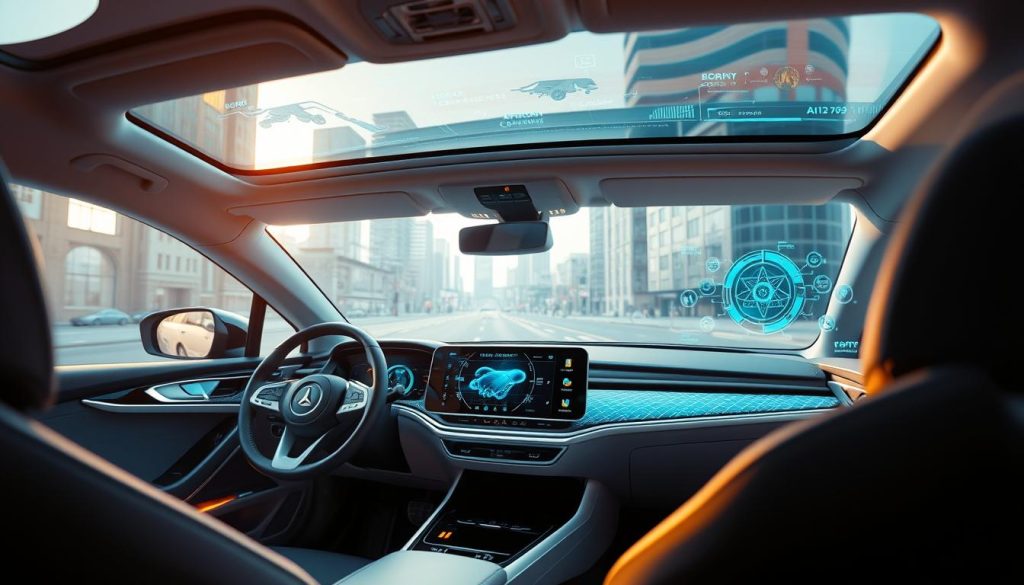
AI-Powered Safety Features
AI is making our roads safer. It helps prevent accidents with advanced systems. These include:
- Lane departure warning
- Adaptive cruise control
- Automatic emergency braking
These features have greatly improved road safety. AI-driven safety features could cut accidents by a lot. Most accidents are caused by human error, which is 97% of cases.
Enhancing the Driving Experience with AI
AI does more than just keep us safe. It makes driving better and more fun. AI-powered systems give personalized experiences to drivers and passengers.
They can suggest routes, play your favorite music, and adjust the car’s climate. The AI market for cars is growing fast. It’s expected to hit $15.9 billion by 2027.
“AI in autonomous vehicles is transforming transportation, leading to safer and more efficient driving experiences.”
As AI keeps getting better, we’ll see more cool things in cars. From predicting when you need maintenance to fully self-driving cars, the future looks bright and safe.
Sustainability in Automotive Design
The car industry is moving towards green mobility. We’re seeing a big change in eco-friendly cars and using renewable energy in car design. This change comes from stricter rules, what people want, and knowing how we affect the planet.
Eco-Friendly Materials and Manufacturing
Car makers are looking for new materials to be kinder to the planet. They’re using natural fibers more and more. In 2015, European car makers used about 50,000 tons of these fibers.
These fibers can save money, too. They might cost 10% to 30% less than what’s used now. A plant called Kenaf is also being used because it absorbs a lot of CO2.
It’s not just about the materials. Companies are also changing how they use energy. A big car company changed its energy use. They used data better and chose cleaner energy sources. This helped the planet a lot.
Renewable Energy Sources for Vehicles
There’s a big push for cleaner cars. Electric cars are leading this change. They’re a better choice than cars that run on fossil fuels.
Solar and wind energy are being used in making cars. This makes cars less dependent on fossil fuels and lowers carbon emissions. Some companies are even thinking about using solar energy in cars themselves.
| Sustainability Measure | Impact |
|---|---|
| Natural Fiber Use | 50,000 tons used in Europe (2015) |
| Cost Savings | 10-30% compared to glass fibers |
| CO2 Absorption | High (e.g., Kenaf plant) |
| Energy Management | Reduced environmental impact |
The journey to green car design is long, but we’re making good progress. As we keep innovating, we’re moving towards a future where green cars and renewable energy are common, not rare.
Smart Cars and Their Features
Smart cars are changing the car world with new tech. They mix cool features with ease, making driving fun. Let’s look at what makes smart cars special and how they’re changing travel.
Integration of Smart Technology
Smart cars have cool features that make driving safer and more fun. They have things like adaptive cruise control and automatic emergency braking. The Mercedes-Benz EQS is a top example with its MBUX Hyperscreen and self-driving tech.
These cars use sensors and cameras to see around them. They watch for other cars, people, and signs. This helps them make smart choices and keep everyone safe.
The Role of Mobile Apps in Smart Cars
Car apps are changing how we use our vehicles. They let you start your car from afar and control the climate. Some cars even let you unlock and start them with your phone. It’s all about making driving easier.
| Feature | Benefit |
|---|---|
| Adaptive Cruise Control | Maintains safe distance from other vehicles |
| 360-degree Camera System | Provides complete view of surroundings |
| Remote Start via App | Allows vehicle preparation before entering |
| Real-time Diagnostics | Enables proactive maintenance |
By 2025, 470 million connected cars will be on the road. This shows how fast smart cars are growing. They promise better safety, less traffic, and better city driving for everyone in the U.S.
The Importance of Cybersecurity in Modern Vehicles
Our cars are getting smarter, and so is the need for car cybersecurity. Connected cars are now a big part of our lives, but they also bring new risks. We must protect our vehicles from digital threats to keep drivers safe.
Protecting Vehicles from Cyber Threats
Protecting vehicle data is key in today’s digital world. Modern cars have millions of lines of code, making them targets for hackers. The National Highway Traffic Safety Administration (NHTSA) stresses the importance of strong cybersecurity measures.
These measures protect advanced driver assistance technologies and prevent safety risks.
Connected car security involves guarding both wireless and wired entry points. NHTSA promotes a multi-layered approach to tackle these vulnerabilities. This includes using encryption, authentication, and intrusion detection systems.
Best Practices for Automotive Cybersecurity
To enhance automotive cybersecurity, we need to follow some key practices:
- Secure software development
- Regular over-the-air updates
- Robust encryption for vehicle-to-everything (V2X) communication
- Collaboration between automakers, suppliers, and government agencies
The Auto-ISAC, an industry group focused on cybersecurity, shares vital information across the automotive sector. This teamwork is key to staying ahead of evolving threats.
“The future of automotive cybersecurity will need to address the complexities brought by emerging technologies like autonomous vehicles.”
As we move towards a future with more connected and autonomous vehicles, the importance of automotive cybersecurity will only grow. It’s up to us to stay vigilant and keep our smart cars safe from digital dangers.
Regulatory and Legal Considerations
The automotive industry is caught in a complex web of rules. These rules are pushing for cleaner, safer cars. They include automotive regulations, vehicle safety standards, and emissions laws.
Current Regulations Impacting Innovation
In the U.S., the Biden administration is pushing for electric vehicles. They aim for two-thirds of new cars and a quarter of new trucks to be electric by 2032. This goal is changing the industry.
Emissions laws are getting tougher. Car makers are investing in new tech to meet these standards. This push for cleaner cars is driving innovation. We’re seeing lighter materials, better computer controls, and more efficient engines.
| Regulation Type | Impact on Innovation |
|---|---|
| Emissions Laws | Development of electric and hybrid vehicles |
| Vehicle Safety Standards | Advanced driver assistance systems |
| Consumer Protection | Improved data privacy in connected cars |
The Future of Legislation in the Automotive Sector
Looking ahead, we expect more focus on autonomous vehicle safety. As self-driving cars become reality, new laws will be needed. Data privacy in connected cars is another hot topic. We’ll likely see rules about how car companies can use and protect driver data.
The shift to electric isn’t without challenges. There are concerns about job losses in traditional auto manufacturing. The industry needs to balance innovation with workforce needs. It’s a tricky but necessary transition for a cleaner future.
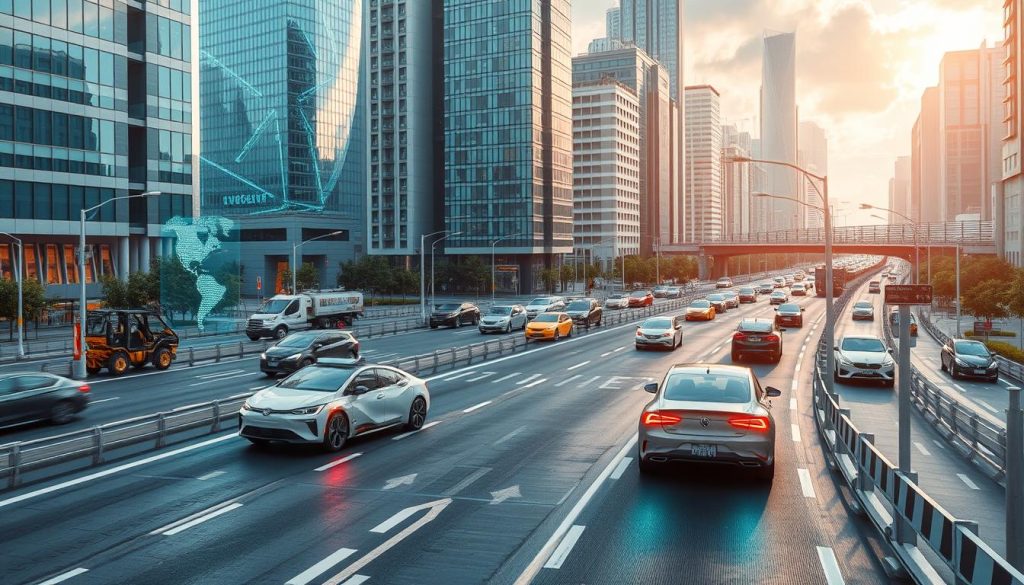
Tesla’s success shows how companies can thrive under new regulations. By focusing on electric vehicles from the start, they’re well-positioned for future rules. Other automakers are racing to catch up, driving more innovation across the board.
Consumer Trends Shaping Automotive Innovation
We’re seeing a big change in the car world. Trends are changing how we see cars and travel. Let’s explore some exciting new things.
Preferences for Electric and Hybrid Options
More people are picking electric and hybrid cars. They like them because they’re good for the planet and save money. This is making car makers work hard to keep up.
| Year | Global EV Sales | % of Total Car Sales |
|---|---|---|
| 2020 | 3.1 million | 4.1% |
| 2021 | 6.6 million | 8.3% |
| 2022 | 10.5 million | 13.0% |
Demand for Advanced Safety Features
People want cars that are safer. They want features that help prevent accidents and keep them safe if one happens. This has led to the creation of:
- Automatic emergency braking
- Lane departure warnings
- Blind spot detection
The future is looking bright. Vehicle-to-everything (V2X) technology is coming. It will make cars talk to each other and their surroundings. This could make our roads safer and more efficient.
The Role of Automakers in Innovation
Automotive manufacturers are leading the charge in revolutionizing the transportation industry. They show their commitment to innovation through rigorous testing and development processes.
Leading Companies in Automotive Technology
Car tech companies are pushing the boundaries of what’s possible on four wheels. Did you know that automakers conduct weather testing at extreme temperatures from -40 to 130 degrees? This ensures that vehicles can perform in any climate.
Additionally, a single auto model may spend up to 200 hours in a wind tunnel to enhance aerodynamics. This accounts for about 20% of a vehicle’s energy usage.
High-performance testing is equally intense. Car doors are subjected to 84,000 open-and-close cycles, simulating 10 years of customer use in various temperatures. On average, automakers accumulate about 2 million miles of on-road and track testing on a single vehicle model – equivalent to 80 trips around the world!
Partnerships with Tech Companies
Industry collaborations are crucial in driving automotive innovation forward. Automakers are partnering with tech giants and start-ups to accelerate progress in areas like autonomous driving and connectivity. These partnerships are essential for establishing safety standards and overcoming legal and ethical challenges.
The shift towards electric vehicles and stricter emission regulations highlights the global move towards environmental sustainability. With over 200 government safety and environmental regulations to meet in the U.S. alone, these collaborations are more important than ever.
As cars transform into mobile devices, the integration of smart technology is creating interconnected ecosystems. This trend towards smart cars and advanced infotainment systems is shaping the future of automotive innovation. It promises exciting developments for drivers and passengers alike.
The Future of Automotive Innovation
We’re on the edge of a big change in how we travel. The car world is moving fast, with electric cars leading the way. New battery tech is making them more popular.
Predictions for the Next Decade
Next year, we’ll see big steps forward in car tech. Electric cars are taking over, thanks to better batteries. The EU just made a big move to standardize charging cables, which could speed up charging times.
Autonomous cars are getting smarter, thanks to new tech. This means safer, more efficient travel for everyone.
The Role of Startups in Driving Change
Startups are key in changing the car world. They’re solving big problems like charging and range. Some are even working on flying cars, like jetpacks and air taxis.
They’re also working on special cars that can take off and land vertically. This could cut down on traffic and pollution in cities. It might even change how cities are built.
It’s all about working together. Big car makers, tech companies, and startups are teaming up. They’re tackling tough issues to make travel better and greener for the future.
How to Get Involved in Automotive Innovation
The automotive industry is a huge force in innovation, adding $1 trillion to the U.S. economy every year. It supports 9.6 million jobs across the country, making it a thrilling field for those who want to innovate. Careers in electrical engineering and software development are booming.
Opportunities for Aspiring Innovators
Auto Innovators, started in 2020, speaks for the whole industry. They say for every job in car making, 10.5 more jobs are created in other areas. This means lots of chances for innovation in different fields.
The Electric Vehicle Dashboard gives insights into the EV market. It shows opportunities in green design and tech.
Education and Resources to Explore
To get into car tech, check out specialized automotive engineering programs. Online courses on new tech like V2X communication and PFAS rules are great for keeping up. Events like the China International Import Expo offer chances to meet people and see new tech.
The Driving Force report by the Alliance for Automotive Innovation gives details on economic indicators by state. This helps find the best places for learning about innovation. With companies investing up to 30% of their R&D in new tech, now is a great time to join the automotive innovation scene.
FAQ
What is automotive innovation?
Automotive innovation means always finding new ways to make cars better. This includes using new technologies, designs, and processes. It’s about making cars more efficient, like electric ones, and safer.
How has the automotive industry evolved over the years?
The car industry has changed a lot since the early 1900s. It moved from making many cars at once to focusing on electric ones. Big steps include using assembly lines, adding safety features, and making hybrid and electric cars.
What are the current trends in automotive technology?
Today, cars are getting smarter and cleaner. Trends include electric cars, self-driving tech, and better connectivity. These changes make cars more efficient and safe.
How are electric vehicles (EVs) changing the automotive landscape?
Electric cars are becoming more popular. By October 2022, they made up 29.4% of car sales in big markets. They’re getting cheaper and batteries are improving, making them more practical for daily use.
What is autonomous driving, and how will it impact mobility?
Autonomous driving means cars can drive themselves. It’s changing how we think about cars. They could become a place for relaxation and help people with disabilities. It might also make driving safer.
How is artificial intelligence (AI) being used in cars?
AI helps make cars safer. It’s used for things like automatic emergency braking and warning drivers when they drift out of their lane. It also makes driving more enjoyable with better infotainment systems.
What role does sustainability play in automotive design?
Sustainability is key in car design now. Companies are using eco-friendly materials and renewable energy. They’re also making cars more efficient to reduce emissions.
What features define a “smart car”?
Smart cars have advanced tech. They connect to the internet, have cool infotainment systems, and work with mobile apps. These features make driving better and more personal.
Why is cybersecurity important in modern vehicles?
Cars are getting more connected, so they need strong security. This includes protecting against threats and keeping software up to date. It’s all about keeping cars safe from hackers.
How are regulations impacting automotive innovation?
Rules are shaping the car industry. For example, the U.S. Inflation Reduction Act helps EVs. European laws aim for all electric cars by 2035. Future rules will focus on safety and privacy.
What consumer trends are driving automotive innovation?
People want electric and hybrid cars more. They also want cars that are safer and can drive themselves. Ride-sharing services are changing how we think about owning cars.
Which companies are leading in automotive innovation?
Leaders include Tesla, Mercedes-Benz, GM, and Ford. They’re pushing electric and self-driving tech. Traditional car makers are teaming up with tech companies to improve cars.
What does the future of automotive innovation look like?
The future is electric and self-driving cars. EVs will soon be as affordable as gas cars. Expect better batteries, AI, and new ways to move around.
How can I get involved in automotive innovation?
You can work in electrical engineering, software, or sustainable design. Look for special programs or online courses. Attend events like the China International Import Expo to learn more.
Source Links
- https://www.wardsauto.com/automakers/-7th-ciie-exploring-the-future-of-mobility-and-automotive-innovation
- https://www.jpmorgan.com/insights/global-research/autos/automotive-innovation
- https://www.forbes.com/councils/forbestechcouncil/2020/02/11/engineering-the-next-era-of-automotive-innovation/
- https://www.simscale.com/blog/the-automotive-race-to-innovation-and-efficiency/
- https://www.epicflow.com/blog/5-latest-trends-in-the-automotive-industry/
- https://www.pwc.com/us/en/industries/industrial-products/library/automotive-industry-trends.html
- https://www.diehltoyotaofhermitage.com/the-rise-of-autonomous-vehicles/
- https://www.automotive-technology.com/articles/autonomous-vehicles-paving-the-way-for-a-self-driving-future
- https://appinventiv.com/blog/ai-in-automotive-industry/
- https://www.fullpath.com/blog/the-impact-and-benefits-of-ai-in-the-automotive-industry/
- https://www.veritis.com/blog/the-impact-and-benefits-of-ai-in-automotive-industry/
- https://jcsr.springeropen.com/articles/10.1186/s40991-020-00057-z
- https://www.pwc.de/en/sustainability/sustainability-in-the-automotive-industry.html
- https://endego.com/blog/eco-driven-innovation-reshaping-the-automotive-industry-for-a-sustainable-tomorrow/
- https://www.autopi.io/blog/intelligent-car-explained/
- https://carbreakers.ie/blogs/news/the-rise-of-smart-cars-features-and-innovations-transforming-the-automotive-industry
- https://www.brewerscience.com/automotive-innovation-6-exciting-tech-advancements-rolling-your-way/
- https://nohau.eu/the-crucial-role-of-cybersecurity-in-the-modern-automotive-industry/
- https://www.nhtsa.gov/research/vehicle-cybersecurity
- https://www.institutedata.com/us/blog/automotive-cybersecurity/
- https://news.climate.columbia.edu/2023/04/17/the-impact-of-regulation-on-automobile-innovation/
- https://blog.aiag.org/auto-industry-hot-topics-current-priorities-and-emerging-issues
- https://www.wissenresearch.com/market-research-articles/innovative-technology-trends-driving-the-automotive-industry-2024/
- https://www.tek.com/en/blog/3-market-trends-driving-automotive-innovation-part-three-the-autonomous-vehicle
- https://www.autosinnovate.org/initiatives/innovation/how-innovation-gets-to-market
- https://www.linkedin.com/pulse/future-automotive-industry-embracing-innovation-george-mienie
- https://www.rsm.global/insights/beyond-grid-future-automotive-innovation
- https://www.imaginationtech.com/future-of-automotive/
- https://www.autosinnovate.org/
- https://www.bain.com/insights/innovation-in-the-automotive-industry/
Share this content:
